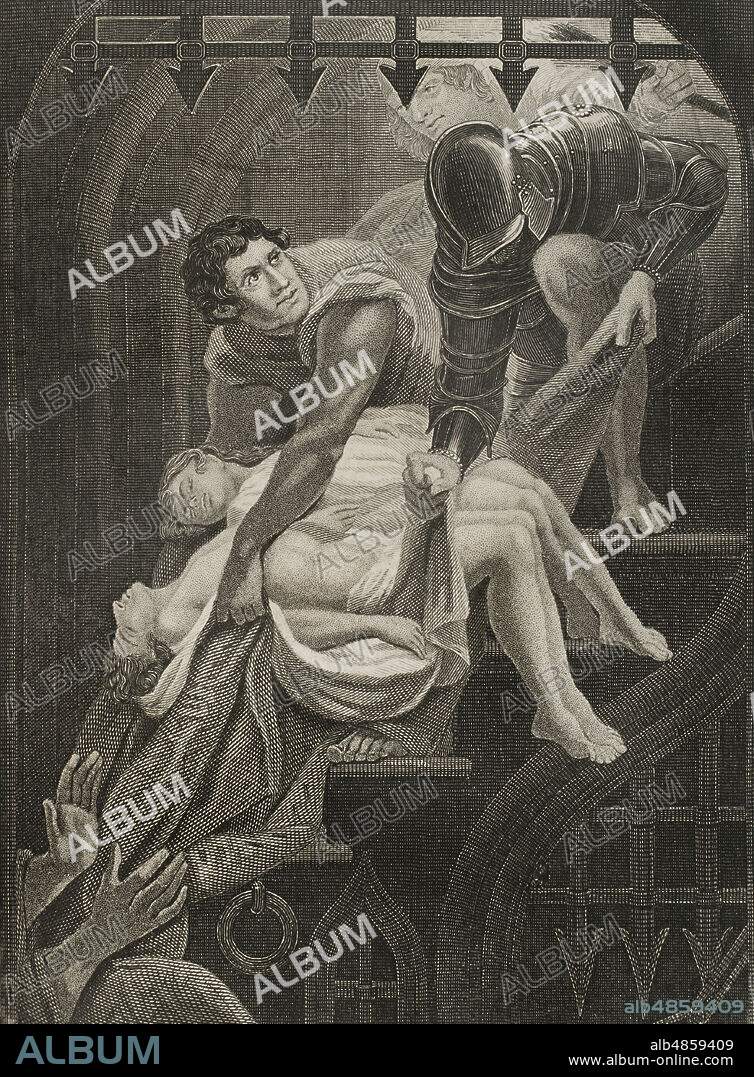alb4859409
After the death of King Edward IV of England (1442-1483), his brother Richard (1452-1485), Duke of Gloucester, took advantage of the fact of being guardian of the heirs to the throne and Lord Protector of the Realm, to imprison his nephews, Edward V (1470-1483) and his brother Richard of Shrewsbury, Duke of York (1473-1483). The princes were murdered by one of Richard's hired assassins, smothering them with a pillow while they slept. Richard had ordered Robert Brakenbury, Constable of the Tower of London, kill his two nephews, but Brakenbury refused. Richard then gave the order to Sir James Tyrrell (ca. 1455-1502), who with the help of three accomplices, named William Slater, John Digton and Forrest, executed the murder. Duke Richard proclaimed himself king in 1483, reigning as Richard III from 26 June 1483 to 22 August 1485. The corpses were buried at the foot of the staircase in the Tower of London, at shallow depths, where they were found on July 1674. The sons of Edward IV. Engraving depicting the Act IV, Scene III, from the tragedy written about 1592 by William Shakespeare (1564-1616), entitled "The Tragedy of Richard the Third". Historia de las persecuciones políticas y religiosas en Europa (History of political and religious persecutions in Europe). Volume II. Published in Barcelona, 1864.

|
Add to another lightbox |
|
Add to another lightbox |



Buy this image.
Select the use:

Caption:
After the death of King Edward IV of England (1442-1483), his brother Richard (1452-1485), Duke of Gloucester, took advantage of the fact of being guardian of the heirs to the throne and Lord Protector of the Realm, to imprison his nephews, Edward V (1470-1483) and his brother Richard of Shrewsbury, Duke of York (1473-1483). The princes were murdered by one of Richard's hired assassins, smothering them with a pillow while they slept. Richard had ordered Robert Brakenbury, Constable of the Tower of London, kill his two nephews, but Brakenbury refused. Richard then gave the order to Sir James Tyrrell (ca. 1455-1502), who with the help of three accomplices, named William Slater, John Digton and Forrest, executed the murder. Duke Richard proclaimed himself king in 1483, reigning as Richard III from 26 June 1483 to 22 August 1485. The corpses were buried at the foot of the staircase in the Tower of London, at shallow depths, where they were found on July 1674. The sons of Edward IV. Engraving depicting the Act IV, Scene III, from the tragedy written about 1592 by William Shakespeare (1564-1616), entitled "The Tragedy of Richard the Third". Historia de las persecuciones políticas y religiosas en Europa (History of political and religious persecutions in Europe). Volume II. Published in Barcelona, 1864.
Personalities:
Location:
PRIVATE COLLECTION
Credit:
Album / Prisma
Releases:
Model: No - Property: No
Rights questions?
Rights questions?
Image size:
3248 x 4413 px | 41.0 MB
Print size:
27.5 x 37.4 cm | 10.8 x 14.7 in (300 dpi)
Keywords:
1483 • 15 15TH XV XVTH FIFTEENTH CENTURY • 15 CENTURY • 15TH CENTURY • 15TH CENTURY; • ACCOMPLICE • ACCOMPLICES • ADOLESCENCE • ASPHYXIA • ASPHYXIATION • ASSASSIN • ASSASSINATION • ASSASSINÉS • BODIES • BODY • BOY • BOYS • BRITAIN • BRITISH • BROTHER • BURIED • BURY • BURYING • CADAVER • CADÁVERES • CHILD • CHILDHOOD • CHILDREN • CITY OF LONDON • CONCEAL • CORPS • CORPSE • CORPSES • DEAD BODY • DEAD • DEATH • DUKE OF GLOUCESTER • DUKE OF YORK • DUKE RICHARD • EDWARD V OF ENGLAND • EDWARD V • ENGLAND'S • ENGLAND • ENGLISH • ENGRAVED • ENGRAVING (ARTWORK) • ENGRAVING • ENGRAVING. • ENGRAVINGS • ETCHING • FIFTEENTH CENTURY • FIFTEENTH • FUR • GAMBLE • GAMBLING • GAME • GAMES • GREAT BRITAIN • HEIR TO THE THRONE • HEIRS TO THE THRONE • HIDE (ANIMAL SKIN) • HIDE • HIDE-OUT • HIDING PLACE • HIDING • HISTORIA UNIVERSAL • HISTORIA • HISTORY • HOMICIDE • HOUSE OF YORK • INFANT • INGLES • JAMES TYRELL • JAMES TYRRELL • KID • KIDS • KILL • KILLER • KILLERS • KILLING • KILLS • LADDER • LITTLE GIRL • LOCKED UP • LOCKED • LONDON • LONDON. • MONARCHY • MURDER • MURDERED • MURDERER • MURDERING • OFFSPRING • ORGANS • PELT • PLAY • PLAYING • PRINCE • PRINCES IN THE TOWER • PRINCIPES • PRINT • PRIVATE COLLECTION • REIGN OF RICHARD III OF ENGLAND • REIGN OF RICHARD III • RICHARD III OF ENGLAND • RICHARD III • RICHARD OF GLOUCESTER • RICHARD OF SHREWSBURY • SCENE • SHAKESPEARE, WILLIAM • SHREWSBURY • SIGLO XV • SIR JAMES TYRRELL • SKIN (ANIMAL) • SLATER • STAGE • STAIR • STAIRCASE • STAIRS • STAIRWAY • STEP • STEPS • SUCCESSOR TO THE THRONE • SUFFOCATED • THEATER • THEATRE • TOWER OF LONDON • TRAGEDY OF RICHARD THE THIRD, THE • TRAGEDY • TYRELL • TYRRELL • U. K. • UK • UNITED KINGDOM • WILLIAM SLATER • XV CENTURY • XV • YOUTH
 Pinterest
Pinterest Twitter
Twitter Facebook
Facebook Copy link
Copy link Email
Email
